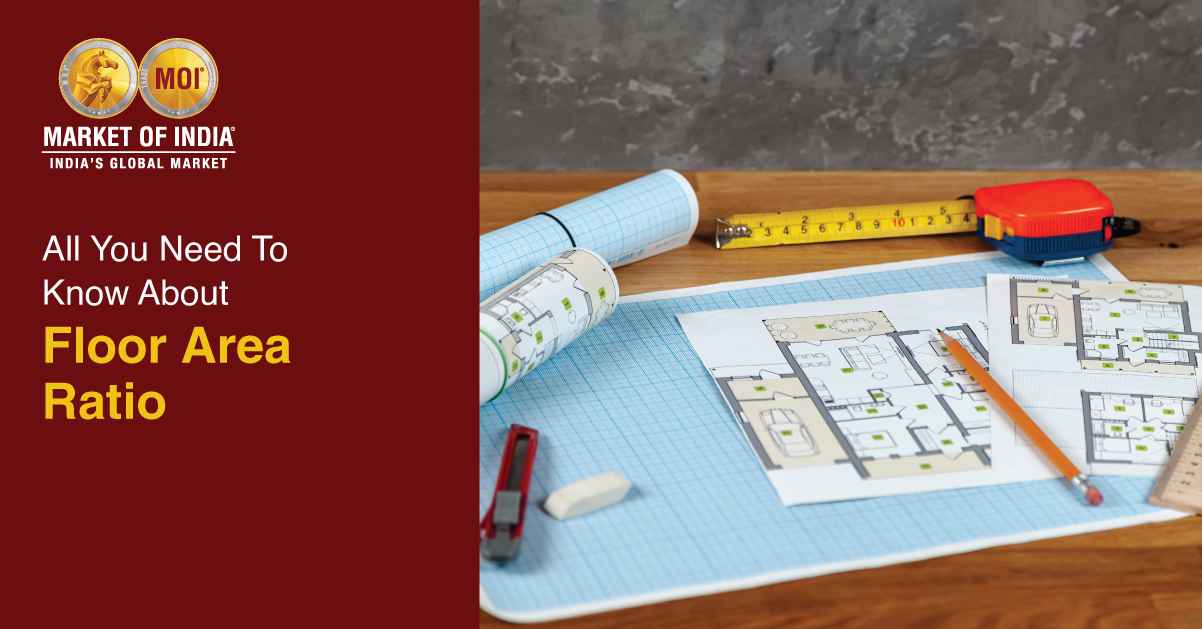How do cities keep growing without spreading into the countryside? The secret is hidden in a simple yet powerful urban planning tool: Floor Area Ratio (FAR).
In this blog post, we’ll uncover how FAR influences the shape and soul of our cities, managing density and dictating the skyline.
Join us as we delve into the world of FAR and discover its pivotal role in addressing modern housing challenges.
1. Introduction to Floor Area Ratio (FAR)
It is one of the critical metrics in the real estate industry. It measures the total building square footage allowable on a given plot of land. It is calculated by dividing the total building area by the plot’s size.
FAR plays a crucial role in establishing the maximum building footprint allowed on a property, impacting factors such as building height, density, and the overall cityscape.
In a nutshell, it helps manage resources and infrastructural capacities, ensuring effective, sustainable development.
Adherence to Municipal Development Control Regulations
Compliance with municipal development control ensures that urban development is sustainable and well-integrated into the city’s infrastructure.
Following these guidelines is essential to avoid overcrowding and uphold the region’s aesthetic and environmental quality.
Additionally, it is instrumental in effective urban planning, influencing traffic patterns, public amenities, and the overall quality of life in urban areas.
2. Calculation of FAR
| FAR= Total Area of the Plot/ Total Built-up Area of the Building |
For instance, let’s consider a scenario where a building occupies a built-up area of 10,000 square feet and is located on a plot measuring 2,500 square feet. The Floor Area Ratio (FAR) would be 4 in this case.
This indicates that the total area of the building is four times larger than the size of the plot.
Having a clear understanding of FAR is of utmost importance for developers and architects. It assists in determining the maximum permissible size of a building that can be erected on a specific plot, ensuring adherence to local zoning laws and regulations.
3. FAR vs. Floor Space Index (FSI)
Floor Area Ratio (FAR) and Floor Space Index (FSI) are utilized to indicate the correlation between the overall built-up area of a structure and the land area it occupies. However, they are applied in distinct scenarios. The ratio of FAR, prevalent in the United States, states the total building area with the plot area.
On the other hand, FSI, employed in India and various other nations, fulfils a similar function but is frequently articulated differently and may encompass additional factors determined by local laws.
4. Importance of Understanding Both Terms in Real Estate
Understanding FAR and FSI is crucial in determining the urban planning strategy. Let us dive into the section on how these two terminologies are essential in the real estate industry, which are as follows:
- Regulatory Compliance: Local zoning laws regulate both FAR and FSI. Understanding these metrics is crucial for developers and builders to ensure that their projects comply with the legal limits set by local authorities, thus avoiding potential legal issues and fines.
- Maximizing Property Value: Developers can increase a property’s economic value by comprehending the limitations and opportunities presented by FAR and FSI. This knowledge allows them to maximize the buildable area on a specific plot.
- Strategic Planning: Urban planners and developers must have a thorough understanding of FAR and FSI to effectively plan building layouts and sizes. This knowledge assists in determining the appropriate building height, residential density, and type of community development suitable for a particular area.
- Investment Decisions: Investors use FAR and FSI metrics to evaluate the potential for property expansion or redevelopment. A higher FAR or FSI may indicate more development opportunities, attracting investors seeking high returns.
- Impact on Infrastructure: Anticipating the effect on local infrastructure, such as roads, water supply, sewage, and public services, is crucial for sustainable urban development. Understanding how FAR and FSI affect area density is essential in this regard.
- Market Analysis: Real estate professionals analyze market conditions and trends using FAR and FSI. Properties with high FAR or FSI potential are often more desirable in urban areas with limited space.
5. Factors Influencing FAR/FSI
- Location: The geographical location of the plot can greatly determine the FAR/FSI assigned to it. Urban areas have high FAR/FSI, which can accommodate higher building densities than rural or suburban areas.
- Municipal regulation: They highly determine the plot’s FAR/FSI. They manage urban sprawl, population density, and infrastructural capacities to achieve strategic urban planning goals.
- Construction activities can significantly impact an area’s FAR/FSI. Over time, the level and nature of these activities can change the FAR/FSI. For instance, when an area is experiencing substantial redevelopment or revitalization, the local authorities may choose to raise the FAR/FSI to stimulate investment and promote modernization.
Understanding these factors plays a pivotal role for developers, planners, and investors. It allows them to make informed decisions that comply with regulatory frameworks and zoning laws.
6. Variability of FAR/FSI
The Floor Area Ratio (FAR) and Floor Space Index (FSI) are subject to significant variations based on various factors, highlighting the adaptable nature of urban planning and development strategies.
- Zoning regulations play a crucial role, with different categories, such as residential, commercial, or industrial, having their own specific FAR/FSI guidelines tailored to the unique requirements of each zone. These regulations directly impact the scale and type of developments permitted within each area.
- Urban and suburban areas exhibit distinct differences in FAR/FSI values. Metropolitan regions, particularly city centres, typically feature higher FAR/FSI to facilitate denser development and taller structures. In contrast, suburban areas often maintain lower FAR/FSI to preserve open spaces and promote lower-density living environments.
- Changes in local government-level policies can influence FAR/FSI values to align with evolving urban development objectives or socio-economic circumstances. For instance, a city might adjust FAR/FSI in specific zones to encourage higher-density projects or mixed-use developments in response to changing needs.
- Special provisions, such as bonus FAR/FSI incentives, may be offered to developments incorporating public benefits like affordable housing, green building initiatives, or community amenities. Conversely, restrictions might be imposed to safeguard historic districts or environmentally sensitive areas from excessive development pressures.
7. Importance of FAR for Homebuyers
- Property potential: Understanding FAR helps home buyers assess the future expansions of the project. It helps to determine the plans of expanding the living spaces or adding additional floors, potentially increasing the property value.
- Property values: Properties with higher FAR/FSI are in high demand. Thus, as property investors, you can gauge their value, as areas with higher allowable development tend to increase /appreciate in value faster than other properties.
- Community density: FAR indicates the neighbourhood’s density, which helps homebuyers make informed decisions about their preferred living environment and lifestyle.
8. Importance of FAR for Developers
- Project Viability: The FAR determines a project’s feasibility, as it sets the limit on the scale of development. A higher FAR enables the construction of more significant buildings, leading to a greater return on investment through increased leasing or selling space.
- Design and Development: The FAR significantly influences project architectural design and planning. Developers must consider the FAR in their designs to optimize space utilization while complying with local zoning laws and building codes.
- Economic Implications: The FAR directly impacts the financial viability of a project. By maximizing the permissible building area, developers have the potential to generate more revenue from the same land plot, thereby enhancing the financial attractiveness of their projects.
9. Potential Benefits of Higher FAR in Addressing Housing Challenges
- Increased housing density
- Enhanced urban affordability
- Optimization of limited land resources
- Promotion of public transit usage
- Diversification of housing options
- Stimulation of economic development
Book your Shop at Market of India
Experience top-tier infrastructure designed for seamless business operations, encompassing everything from advanced security measures to comprehensive logistics support.
With a diverse selection of shops and office spaces starting at ₹45 lakhs, the Market of India offers many opportunities for entrepreneurs looking to expand.
Benefit from our attractive Assured Rentals of Rs.100 per sqft, making the Market of India a commercial hub and a lucrative investment choice.
Strategically located within Chennai’s most extensive integrated township, Market of India enhances its appeal with facilities like parking for over 10,000 vehicles, a sprawling 1.5-acre central plaza, and a vibrant mix of markets and trades, providing all the essentials for businesses to thrive.
Don’t miss out! Secure your space at India’s largest upcoming wholesale and retail marketplace, where cutting-edge security and infrastructure elevate your business to new heights of success!
Wrapping Up
In conclusion, the Floor Area Ratio (FAR) shapes our urban environments. It goes beyond being a mere numerical value and serves as a crucial tool for promoting sustainable growth, optimizing space, and improving city residents’ overall quality of life. Whether you are a developer, a homebuyer, or simply a city dweller, understanding the impact of FAR can provide valuable insights into the future of urban living.
FAQs
1. What exactly is the Floor Area Ratio (FAR)?
FAR is a measurement used to determine the maximum height at which buildings can be constructed on a given plot of land. It is calculated by dividing the total building area by the plot’s area.
2. Why is FAR considered important in urban planning?
FAR plays a vital role in managing building densities and ensuring the sustainable development of urban areas. It helps strike a balance between growth and the capacity of infrastructure.
3. Can the FAR value vary within the same city?
Yes, the FAR value can vary significantly within a city depending on factors such as zoning laws, intended land use, and specific goals for urban development.








0 Comments